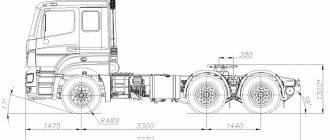In April 2013, GAZ began production of its new light-duty vehicle GAZelle-Next, designed to expand the range of the plant's products on the Russian market. The car was highly appreciated not only in the Russian Federation, but also on the international market - in 2014, all the necessary documents were received for it to be sold in the EU, and production began in Turkey. The main differences of the new model were a completely new and modern design, the use of modern casting and stamping technologies, the installation of more economical and powerful power units, as well as a number of other improvements. Today, GAZelle-Next is produced in various versions, ranging from flatbed vehicles and all-metal vans to buses and special equipment.
Gas consumption for gazelles with a 405 engine
For any car there are certain standards for fuel consumption - the rate is given in liters per 100 km. But these figures are conditional; they do not take into account the operating conditions of the machine. As a rule, control fuel consumption is measured on a flat asphalt road at a certain speed. Factory workers do not take into account engine warm-up, vehicle load, or road conditions. Almost always the given standards are less than the actual fuel consumption. But for approximate calculations, the indicated figures are still taken into account; you should only add 10-20% to the result obtained. Fuel consumption table for various Gazelle modifications
Considering that cars of the Gazelle family are produced with engines of different models, the standards are also set differently. To have some idea about them, it is easier to create tables. The first table shows data for Gazelles with a gasoline engine.
| Automobile model | Engine model, type | Engine capacity, liters | Control consumption, per 100 km |
| GAZ 3302 | ZMZ 402 | 2,445 | 11,0 |
| GAZ 33022 van | ZMZ 402 | 2,445 | 12,5 |
| GAZ 33027 4WD | ZMZ 402 | 2,445 | 13,5 |
| GAZ 33023 farmer | ZMZ 406 carb. | 2,286 | 11,5 |
| GAZ 3302 | ZMZ 406 injector | 2,380 | 11,0 |
| GAZ 3302 | Chrysler | 2,460 | 11,5 |
| GAZ 3302 | UMZ 4216 injector | 2,890 | 11,5-13 |
| GAZ 33023 farmer | Chrysler | 2,460 | 11,0 |
| GAZ 33027 4WD | ZMZ 406 carb. | 2,286 | 12,5 |
| GAZ 330273 4WD | UMZ 4216 injector | 2,890 | 12,5-15 |
The following table is for diesel engines.
| Automobile model | Engine model, type | Engine capacity, liters | Control consumption, per 100 km |
| GAZ 3302 | GAZ 560 turbocharging | 2,134 | 11,0 |
| GAZ 33027 4WD | GAZ 560 turbocharging | 2,134 | 12,5 |
| GAZ 33023 farmer | GAZ 560 turbocharging | 2,134 | 11,0 |
| GAZ 3302 | Cummins ISF | 2,781 | 10,3 |
| GAZ 33027 4WD | Cummins ISF | 2,781 | 11,3 |
The data is all approximate, because it differs in different sources of information.
How are regulations regulated?
A vehicle requires fuel to operate. Each category of car requires different volumes of fuel and lubricants. The Ministry of Transport has developed a special standard - this is the fuel consumption rate for car brands. The standard allows you to determine how much fuel and lubricants a specific brand of vehicle requires to support the technological process. The standards are developed only in relation to the operating process of vehicles. For example, it is unacceptable to use values to calculate the write-off of fuel and lubricants during repair, adjustment or testing. For technological purposes, additional fuel consumption standards (FLC) should be established.
The Ministry of Transport introduced the standards by a separate Order No. AM-23-r dated March 14, 2008 (as amended on September 20, 2018). The document establishes several categories of standards for fuel and fuel consumption:
- Basic standard for gasoline consumption in liters per 100 km in running order.
- Transport standard in liters per 100 km in operation (during transport work), including:
- cost standard for a bus taking into account curb weight and nominal passenger load;
- consumption standard for dump trucks, taking into account equipment and nominal vehicle load.
- Transport standard for a truck in liters per 100 ton-kilometers, determined during transport work.
Standards are set in liters, for example, for gasoline or diesel fuel. Or the standards are fixed in cubic meters if, for example, transport consumes gas.
Gazelle Business Gazelle model 33026 244
Such auxiliary parts as a stove, radios or other audio systems, air conditioners, always-on headlights, wipers, even the use of winter tires affect fuel consumption. The number of cylinders in a car of this brand depends on the volume; the larger the volume, the more parts are needed for its operation, and, accordingly, the more you have to spend on the trip.
| Engine | Consumption (highway) | Consumption (city) | Consumption (mixed cycle) |
| 2.4 (gasoline) | 12 l/100 km | 16 l/100 km | 14 l/100 km |
Accounting for fuel and lubricants standards
Working volume, l Gearbox Fuel consumption rate, l 100 km 1 2 3 4 5 GAZ-2310 Sobol; UMZ-4216 107 2.89 5M 15.2 GAZ-2310 Chrysler 133.3 2.429 5M 13.7 GAZ-A21R22 Next Cummins ISF2. Let's consider what standards for fuels and lubricants are relevant today, how they depend on the season, as well as the nuances that may arise when justifying their write-off in ambiguous cases.
Equipment for the Gazelle 2705 Sable model
| Gazelle with engine 4216 how to reduce fuel consumption - Automotive Magazine It is impossible to independently check for spark failure, breakdown of high-voltage wires and interturn short circuits on the ignition coil. Clutch Single-disc, dry, hydraulically driven Gearbox Mechanical, 5-speed with synchronizers in all gears Gear ratios 1st gear 3.786 2nd gear - 2.188 3rd gear 1.304 4th gear -1.0 5th gear 0.794 Reverse 3.28 Transfer case for cars type 4 4 Mechanical, has two higher gears il.07 and low il.87, as well as a symmetrical center differential with forced locking Cardan transmission Two shafts with three cardan joints and an intermediate support Three shafts for cars of type 4 4 with six cardan joints Front axle of cars type 4 4 main gear Hypoid, gear ratio 4.556 differential Bevel, gear steering knuckles With cardan joints of unequal angular velocities Rear axle main gear Hypoid, gear ratio 4.556 differential Bevel, gear. |
- promptly check all systems and components of the Gazelle and carry out their repairs in a timely manner;
- use only high-quality fuels and lubricants;
- adhere to the basic rules for operating the Gazelle 405 with an injection engine;
- if you do not have sufficient experience in servicing injection engines, contact service station specialists;
- reduce to a minimum the use of air conditioning, high beams and all other additional devices;
- Carry out tuning of the Gazelle after a certain number of kilometers.
Gazelle Business became available to everyone starting in 2010. Its main features:
- Triple cabin. That is, in addition to the driver, Gazelle 3302 also allows you to transport two more passengers;
- The model's carrying capacity is one and a half tons;
- The package initially includes an awning.
Body characteristics are as follows:
- With a total length of the vehicle of 5.48 meters, the body accounts for exactly three meters. This is a kind of standard;
- Width – 1.9 meters;
- The minimum height inside the tent is 1.57 m.
The machine has small metal sides that can be easily lowered; the awning cover can last at least ten years. It copes well with protection from moisture and has excellent frost resistance. The total volume of the working space is nine cubic meters.
Vans from 2008
The certificate in Form 2a contains information about the installed equipment and confirms its certification and compliance with established standards. It reflects the number of installed cylinders and their numbers.
Specifications
- poor quality of cooling system components often leads to overheating;
- The timing chain breaks regularly (the valves do not bend);
- there are lubricant leaks from the gap between the oil deflector and the valve cover;
- many problems with ignition coils, sensors and high-voltage wires
- The oil scraper rings quickly become stuck and oil burns appear.
An injector is a special system for injecting fuel into a car engine. Unlike the operating system of a carburetor engine, here fuel is forcibly injected into the cylinder using injectors. Because of these features, cars with such systems are called injection.
Technical characteristics of the car: suspension and transmission. Engine repair UMZ 4216
As the name suggests, this element is located close to the engine valves, through which air enters the combustion chamber and exhaust gases exit from it. You can accurately determine the level of appetite of a GAZelle, taking into account all factors: year of manufacture, power, condition of the power unit and frequency of maintenance.
| Clutch | Single disc, dry, hydraulically driven |
| Transmission | Mechanical, 5-speed with synchronizers in all gears Gear ratios: 1st gear - 3.786 2nd gear - 2.188 3rd gear - 1.304 4th gear -1.0 5th gear - 0.794 Reverse gear - 3.28 |
| Transfer case for 4x4 vehicles | Mechanical, has two gears: high (i=l.07) and low (i=l.87), as well as a symmetrical center differential with forced locking |
| Cardan transmission | Two shafts with three universal joints and an intermediate support Three shafts (for 4x4 vehicles) with six universal joints |
| Front axle of 4×4 vehicles: | |
| main gear | Hypoid, gear ratio - 4.556 |
| differential | Bevel, gear |
| steering knuckles | With cardan joints of unequal angular velocities |
| Rear axle: | |
| main gear | Hypoid, gear ratio - 4.556 |
| differential | Bevel, gear |
Boosting ZMZ 405.Turbine.Compressor
where Qn is the standard fuel consumption of GAZ per 100 km, l; S mileage of a car or road train, km; Hsan is the fuel consumption rate for the mileage of a GAZ vehicle or road train in running order without load;. Slightly lower fuel consumption is indicated for cars of the Gazelle Business family. The thing is that for the newer generation of cars, and they went into production after 2010, the power units were already modified, and the engines began to meet Euro-3 environmental standards.
Repair: Gazelle 2705 sable
| What is the gas consumption for gazelles - Car Expert The new Gazelle Next has been produced at the Gorky Automobile Plant since 2013; at first, only one type of internal combustion engine, a 2.8-liter Cummins turbodiesel, was installed on this model. Subsequently, the main power unit for cars in this series became the Chinese-made engine Cummins ISF 2800, which is also a four-cylinder device. |
| What is the gasoline consumption of a gazelle? Often entrepreneurs are faced with the need to determine the fuel consumption of a car, to calculate a business plan and in other matters of doing business. Let's consider the main qualitative characteristics of this engine model, operating principles, and also determine the advantages and disadvantages of using a fuel injection system. |
- Gas-Petrol 40% of the time mileage is on gasoline and 60% of the time mileage is on gas
- Gas-diesel 20% of the time mileage in diesel mode and 80% of the time mileage in gas-diesel mode
Niva 21213 injector reducing fuel consumption • It is better to choose a longer path, but without holes and potholes;.
Appearance
The very first thing that catches your eye on a new truck is the design of the cab. With its silhouette, it looks a little like Gazelle Next. Here you can also find angular, laconic and business style.
The medium-duty truck has the installation of modern elegant optics, a fully updated interior, which has 3 comfortable seats. For the first time in the entire history of truck families, the Gorky Automobile Plant began to use plastic front fenders, and the cab itself received a galvanized coating.
It is important to note that in previous Lawn models the cabin was a weak point - it almost immediately began to rust. New trucks now have voluminous side mirrors called “burdocks,” which significantly increase the driver’s visibility.
As a separate option they can be supplied with an electric heating option. They decided to add a massive bumper to the Lawn Next cabin, which made the car a little angular. The appearance of the car cannot be called super attractive, but in a stream of vehicles the new product can immediately stand out.
If we talk about the body itself, it is made of steel. As a separate option, you can order an aluminum body, which has increased corrosion resistance. LAWN Next City received a reduced loading/unloading height, which made it more suitable for work in cities.
Fuel consumption GAZ GAZelle 2nd restyling 2010, bus, 1st generation, 3221
So the spoiler on the Gazelle is not installed for beauty at all, and it is much more useful for the car than the incomprehensibly needed and widely advertised magnetic activators. If you need to go, say, to the office, and you start driving an hour before traffic jams or, for example, set off from Moscow to the south early in the morning, when there is not yet heavy traffic on the roads, then you can count on additional fuel savings.
Capacity. Gazelle next
GAZ-322132 is a special car with which an entire era of minibuses is associated, since no foreign analogue was used in this capacity so massively. Often the Ulyanovsk engine overheats, and drivers take various measures to get rid of this unpleasant and dangerous phenomenon for the internal combustion engine.
| Type of oil pressure sensor | Malfunction | Manifestation |
| Emergency | break or increase in contact resistance | The warning light does not light up |
| sticking of contact electrodes | The warning light is constantly on | |
| violation of the integrity of the diaphragm | low sensitivity of the sensor, the warning light goes out only at high speeds | |
| sensor leakage | oil leakage from the sensor | |
| Control | rheostat break | no pressure indicator readings |
| increase in moving contact resistance | low blood pressure readings | |
| violation of the integrity of the diaphragm | no readings or low blood pressure readings | |
| sensor leakage | oil leakage from the sensor |
Lubrication group • Gazelle next
| High fuel consumption 4216. double-row bushing-roller chains with plastic shoes won for a mileage of more than 250,000 km and got bored because no one was coming back, so I changed the vector of attack. Due to the inertia of fuel combustion, short-term and sharp jerks due to a malfunction of the fuel system are not possible and the main attention should be focused on checking the spark plugs, high-voltage wires and the correct operation of the ignition coil. |
| GAZelle-32213: GAZ-322132, technical characteristics, fuel consumption, prices. All the advantages of a gas engine can be used by those who need a car for commercial purposes, that is, the vehicle is constantly in use. The fuel consumption of the RT will be higher even if trips are made over short distances, and you often have to turn off, start and warm up the engine; |
- In the cold season, when the engine takes a long time to warm up;
- From the condition of the roads. A route with frequent ups and downs also contributes to increased consumption. The mode in which the car moves also affects. In the city, fuel consumption is always higher than on a country road;
- In case of malfunctions in the fuel system or in the engine itself. On gasoline engines, failures often occur in the ignition system; on diesel engines, the fuel injection pump may not be adjusted;
- From driving style. The most economical is considered to be a smooth ride without sudden acceleration. In this case, the speed of movement should be optimal;
- On a loaded vehicle;
- With low tire pressure. At low pressure, the resistance to vehicle movement increases, and more fuel is required to overcome the resistance;
- On all-wheel drive model.
What standards should be used when writing off fuel and lubricants?
You can get more materials on the topic “Doing Business” ConsultantPlus .
Page content
When an organization owns and manages one or more company vehicles on its balance sheet, it is constantly faced with the task of purchasing fuel, justifying its use, and writing it off as expenses.
Current tax rules allow you to reduce the income tax base due to this write-off, but only if they are correctly justified in the relevant reporting documentation.
Therefore, it is extremely important to correctly keep records of spent fuels and lubricants and comply with the write-off standards established by the Ministry of Transport of the Russian Federation.
Let's consider what standards for fuels and lubricants are relevant today, how they depend on the season, as well as the nuances that may arise when justifying their write-off in ambiguous cases. We will show with an example how to correctly calculate the standard calculation of write-off of fuel and lubricants.











